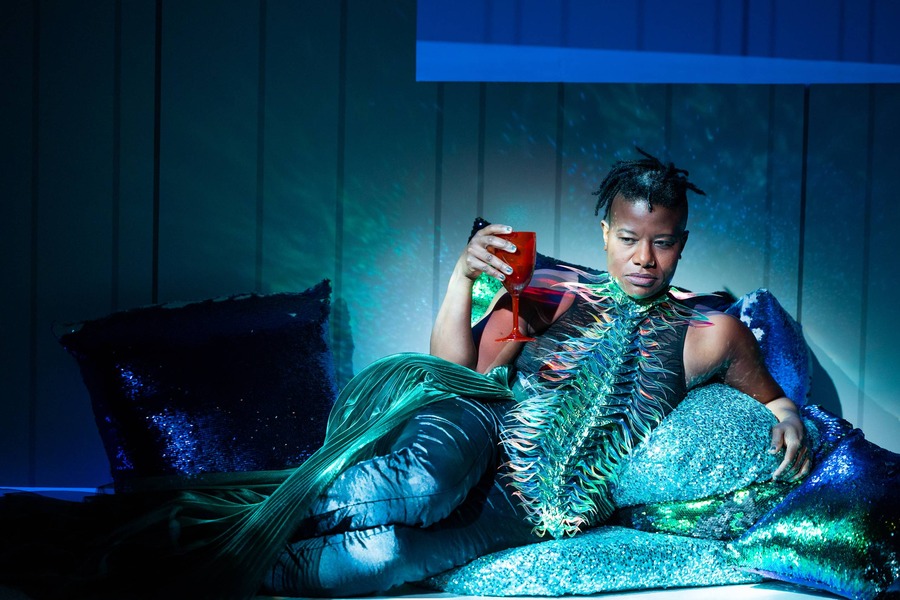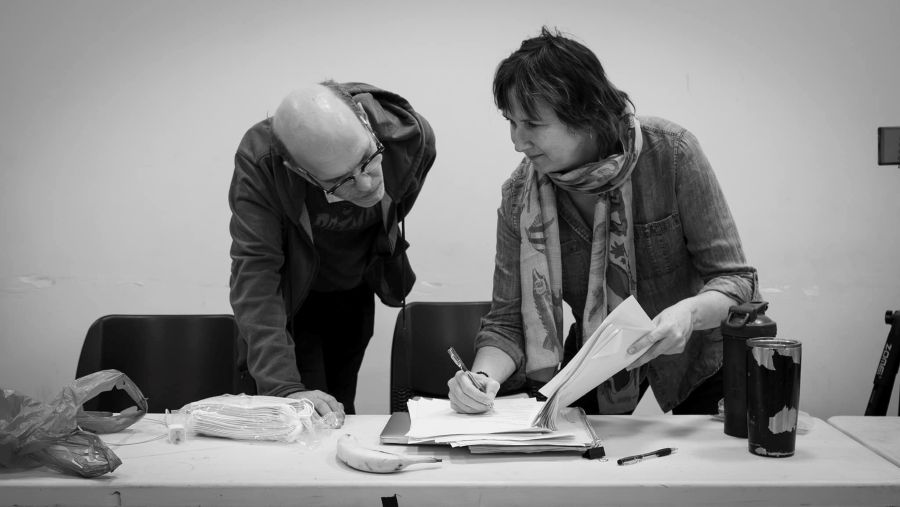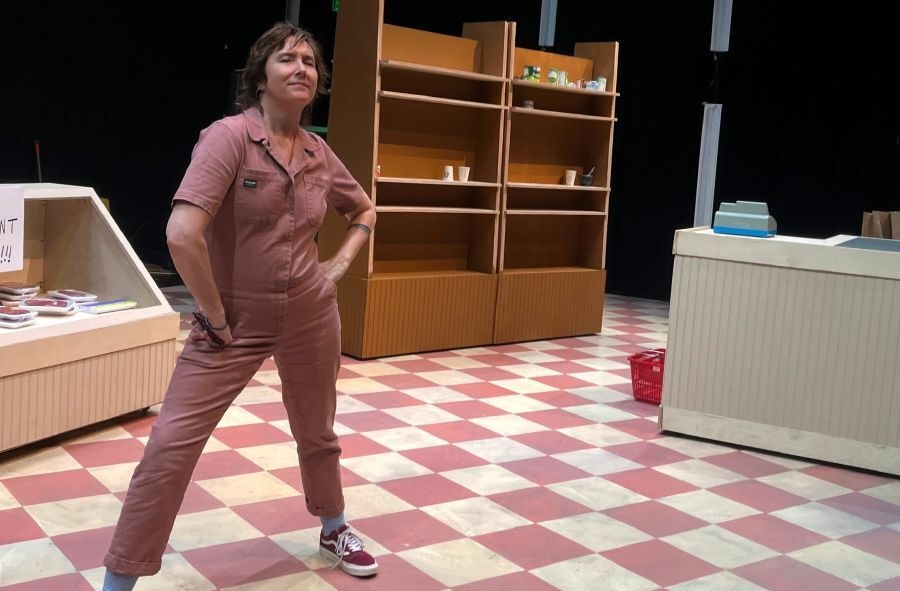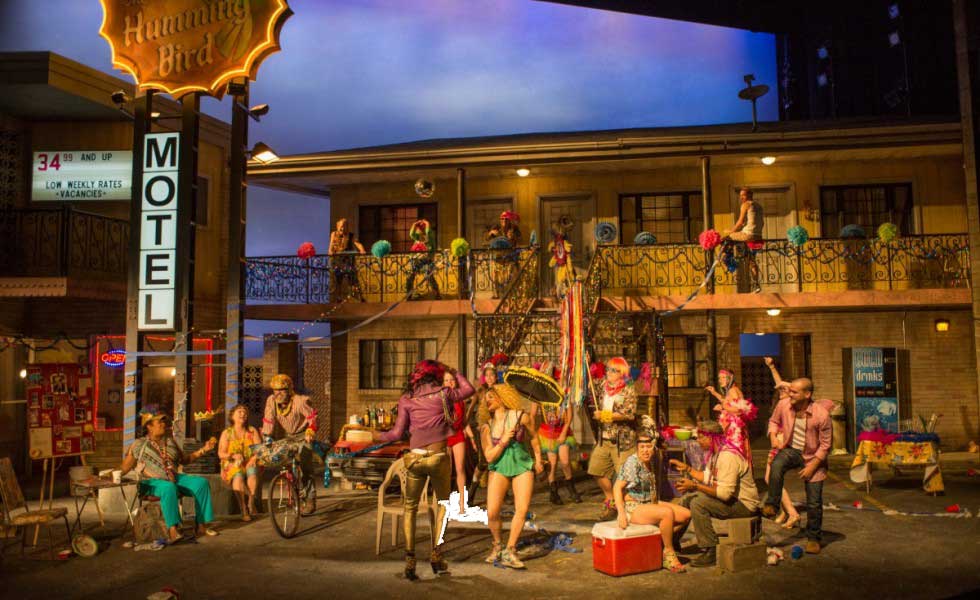In one of the first few scenes of Lisa D’Amour’s wild new play Frozen Section, a nonbinary grocery clerk named Sage chats about their gender nonconformity with a customer who’s more concerned that she may be overcharged at the register. For a moment as I read the play, I thought: trans rights and inflation, check—two issues that supposedly influenced last year’s presidential election outcome.
But D’Amour hasn’t written a play about contemporary politics per se, though Frozen Section—in its world premiere at Houston’s Catastrophic Theatre, Apr. 4-19—has a post-apocalyptic vibe that resonates uncomfortably with our current moment of national upheaval and uncertainty. Set in a Tyler’s grocery store we soon come to realize is no longer fully operative, D’Amour’s bleakly witty yet sneakily warm play follows a group of former staff and patrons (and a talkative coyote) as they gather in and around the store’s shelves to reenact fragments of normal life as they used to know it. As in Anne Washburn’s Mr. Burns, a Post-Electric Play—a play D’Amour told me she didn’t have in mind as she wrote, but which she recognizes as a “strange second cousin” to Frozen Section—we never quite learn the exact story of the end of the civilization. All we know is that these lost souls have each other. The question for them, and for all of us now, is: Are we enough for humanity to survive?
D’Amour is in the midst of a slight resurgence, though she never really went away. After many years of experimental work, much of it with her PearlDamour partner Katie Pearl and with companies like Infernal Bridegroom (Catastrophic’s predecessor), she burst onto the national scene a decade and a half ago with Detroit, a haunting play about aimless exurb dwellers that ran at Chicago’s Steppenwolf Theatre in 2010 (and in this magazine the following year), then came to New York’s Playwrights Horizons in 2012 and hit our Top 10 Most-Produced list the following season. She followed that up with the large-cast drama Airline Highway, set in her native New Orleans, which was a success at Steppenwolf but closed early in its 2015 Broadway bow at Manhattan Theatre Club.
She was back at MTC recently for a reading of a new play called Helene, and has a number of other plays in the works. But she has hardly been idle: PearlDamour has been busy in the intervening years with the MILTON project, with Lost in the Meadow, a large-scale outdoor piece at a Pennsylvania botanical garden called Longwood Gardens, and with Ocean Filibuster, a piece commissioned by American Repertory Theater and the Harvard Center for the Environment, which premiered amid Covid and has been touring intermittently ever since.
In the interview we published with the playscript of Detroit, D’Amour told dramaturg P. Carl that she thought of these two sides of her career—the “straight” plays and the immersive spectacles with Katie Pearl—as “satisfying two different parts of my brain.” I spoke to her recently about those two sides of her brain, about jamming with the weirdos at Catastrophic, and about what she’s learned from teaching theatre.
ROB WEINERT-KENDT: Detroit felt like a kind of crossover from your experimental side to your more traditional playwriting side. Having read the script, Frozen Section feels a little closer to some kind of middle place: sort of naturalistic, but also pretty fantastical and non-linear. Can you tell me about the world you’re building onstage?
LISA D’AMOUR: Frozen Section was a commission from Catastrophic, so I was writing it especially for their sensibility and their ensemble. They’re a theatre that will allow me to lean into the strange, so I was thinking about how I could be very free in that way. Jason Nodler, the director, was really encouraging me to free-associate as I wrote, so when I wrote the scenes that eventually became the play, I wasn’t necessarily writing them in order. I kind of knew we were in this netherworld grocery store situation. I kind of knew that these characters probably lived in this space because there was nowhere else to live. So I was really just riffing on pairs of people who had found some kind of refuge in this Tyler’s grocery store.
When we talk about the play in rehearsal, we talk about it as though something has happened to the world, and most people are living off the grid, using generators; a lot of people have gone post-apocalyptic. What we often say is these characters are cosplaying the old days. So we use that as a frame, and for the actors to make decisions about their characters. I feel like the play works as a story about this community, but I also feel like the play works as a piece of poetry, right? It works in the way you kind of follow images through the play, and it works in terms of spectacle and music toward the end of the play.
I am not completely sure myself if the food they’re talking about in the play is real or fake; I’m not sure how much food there is left in the world. The set is a kind of big open grocery store space with fluorescent lighting on the walls and the ceiling; I gave Catastrophic a lot of reference photos of Fisher Price children’s toy grocery stores, so there’s a feeling of that. There are a lot of units that can roll in and out as grocery aisles and frozen sections and cashier stands. It’s a very fluid space.
Have you ever worked in a grocery store?
Not really, but I do think about my first job, working in a donut shop in suburban New Orleans in the ’80s. The soundtrack of this play comes from that job. I feel like that was its own universe: the people that worked at the grill, the teenage girls who sold the donuts, the regulars at the counter. So in Frozen Section I draw on that feeling of that little world, which was a kind of refuge for some people.
I also worked at Whole Foods before it really expanded. This was in the ’90s in Austin. I worked in the admin offices; I worked for the guy who would go out to other grocery stores and take notes on their specials and what they were doing. He was always bringing me these tapes where he was trying to covertly record what he was seeing in these other stores, and I had to transcribe them. I think about that world too—of spies in grocery stores.

How have you been balancing the two sides of your work in the past few years?
PearlDamour projects take a long time; we develop them slowly. Lately we’ve been working with a group of folks to create something called The Climate Sing, commissioning 13 new songwriters to write a cappella songs about the natural world and then having a giant singalong festival in 2026; we’re working with Niegel Smith at the Flea Theater and Amanda Cooper, our tour manager. So PearlDamour is still very much in my life.
In terms of plays, I feel like a lot is coming back online right now. I wasn’t a great pandemic writer; I was a little shut down by it all. I wrote one play called The Smoker that is going to have its first reading as part of the Alley new-play festival in the fall. I’ve also been commissioned to write the book for a Shania Twain jukebox musical.
Amazing! Tell me more about that.
It’s been like endless drafts, like every musical. It’s an original story that I wrote using her songs; it’s not about her. It’s been great fun. And now Frozen Section and Helene—I feel like I still am using both parts of me. Sometimes I describe it as the introvert and extrovert sides of me, because the PearlDamour work is very collaborative and hands-on, cooking things with Katie, and the playwriting is much more solitary.
Do you feel like the experimental work informs your playwriting, and vice versa, or are the compartments pretty separate?
They totally inform each other, yeah. In the PearlDamour pieces, there’s a musicality to them and a physicality to them; the visuals and the choreography are as much of a driving force as what is said. With a play like Frozen Section, especially because Catastrophic loves the strange, I brought a lot of PearlDamour sensibility to it. I was not afraid to use associative logic rather than linear storytelling logic. My new play, Helene, that we just read at Manhattan Theatre Club, is much more naturalistic. It’s a play about a woman on a road trip, and when she’s in her car, we hear her recorded voice. But sometimes she floats out of the car. I see that very much as a blending of PearlDamour and my more traditional playwriting. So no, I can’t keep them totally separate.
Frozen Section feels very contemporary. Was it written for this moment?
I guess I started it late last year, but I was really finishing it up in January.
I ask because its apocalyptic vibe feels very much of the moment. Do you know the Caryl Churchill play Escaped Alone? The moment when your characters repeat the exchange “Horrified and troubled” and “Troubled and horrified” reminded of the moment in the Churchill play where one woman says “Terrible rage” 25 times in a row.
Oh yeah, I hadn’t thought about that. The things we recycle!
I don’t think you recycled it—more like, great minds think alike.
That scene I definitely wrote last year. I wrote it without any character names attached to it; it was like a choral thing. Then, as I got to know the characters and who was going to be there, I assigned names to them. But yeah, with this play Frozen Section and Helene that we just read, I’m like, “Oh my God, the world is really catching up to these plays in some intense ways.” It’s not that I think we’re literally going to reach the end of days with no electricity and no food. But I think we’re all feeling a little bit unhinged right now about what is real, what is safe, who to believe, what is healthy. This play is really about a community of people who can only keep themselves sane by keeping up this pact of, “Okay, we’re living in grocery store world. We’re not gonna go out and find the cell tower and get looped into whatever craziness is out there.” It’s a play about looking to community to stay sane and to decide: This is the healthiest reality I can live in.

Years ago in this magazine, you described Detroit as being about people not feeling they were on solid ground in America anymore. That feels even more the case now.
We’re actually trying to get together a revival of it right now, with Anne Kaufman, who directed it then. It’s very weird to me: like, the economy and housing, here we are again. I keep saying maybe I should update the play, and Anne is like, “I don’t think you’re gonna have to.”
One of the characters in Frozen Section talks about Detroit.
Yes, Sage wants to go to Detroit, where they had a pen pal for a couple years.
What is it about Detroit as a symbol of American decline, and maybe, as it is for Sage, a sign of promise and possible rebirth?
I’m a Southerner. I’ve spent very little time in the Midwest, so I think I have this very mythic idea of what Detroit is. When I was growing up was when Detroit was going into decline; auto factories were closing down, so it became a real-time symbol of the death of the American dream. But also in terms of the music industry, Detroit looms large in our imagination. In almost the same way Sage is romanticizing Detroit as a place where there’s clean water, I wonder how much of my obsession with Detroit is me simply romanticizing it. You know, it’s not flashy like New York or Chicago. Maybe it’s a little bit kin to New Orleans: We have our tourism, but we’re a small city in a very poor state. There’s an underdog quality.
I’ve always wondered, has the play been done in Detroit?
Yeah, and I saw it. They did it at a place called the Hilberry Theatre; it’s connected to the university there, and they use graduate actors to do it. We changed a few things to make it more Detroit-specific, which mainly meant changing the names of interstates and strip clubs. They did a great production of it, and we had a great discussion about the title after the show. Every time we have a discussion around the title, the audience is 50/50 split: Half of them think it’s the perfect title, half of them don’t quite understand it. And I love that. I love when a play is gonna spark debate.
I’ve read about Catastrophic’s work and talked to Jason before, but have never seen it. How would you describe it?
They work out of this great 150-seat black box theatre in downtown Houston that they helped design. Several companies use it. Over the past year and a half, I’ve seen Happy Days by Beckett, which was a revival of a production they did years ago with Tamarie Cooper in the lead. It was incredible. And then I saw a new play by an Afrofuturist playwright named Candace D’Meza, Miss LaRaj’s House of Dystopian Futures—a sort of futuristic fable in which the elements and soil can speak. Then I saw a production of a Mickle Maher play, Spirits to Enforce; they’re big Mickle Maher fans, they produce his work all the time.
What I’m amazed by is that all of their plays this year were either world premieres or revivals of new plays. And all of their tickets are pay-what-you-can. They really have a loyal following. Jason Nodler would be the first to say, “Our theatre company is just a refuge for weirdos.” What I love about their ensemble—which isn’t an official ensemble, it’s just a bunch of people that work with them all the time—is that it’s people of a lot of different ages and shapes and sizes and races and genders. Everyone is very committed to the health of the theatre company. So I see people taking care of each other in a crazy world. I wonder if that’s part of why I wind up writing these intentional community plays.

You teach a lot. What are you telling your students about the world they’re entering?
I’ve taught at Brown on and off, I teach at Hunter College regularly, and now I’m teaching at University of Houston. I also just did a residency for four days at the University of Southern Mississippi, teaching some workshops, and they did some readings in my plays. So I’m really getting a glimpse of the theatre education landscape across the United States. First of all, this whole idea that theatre is dying—I don’t adhere to that. I think it’s been around since the beginning of time. It will continue to be. I feel really lucky that my own career path has taken me in so many directions—community-based theatre, theatre in tiny spaces, theatre outside, collaborating with dancers—because I feel like that kind of flexibility, the feeling that you can kind of make your own way as a theatre artist, whether you’re an actor, a director, a technician, is really important in general and especially important now. Because at this moment, it’s hard to depend on institutions. Maybe it’s been hard forever, but right now it’s especially hard.
I also feel it’s getting more and more expensive to live in cities, which used to be what you’d do immediately after graduating from college or grad school. So I really am feeling like it’s the time to try and forge your way in smaller theatres—to start your own theatre company in a smaller city. So when I’m teaching playwrights, I’m often pointing them to playwrights who have started their own theatre companies, whether it’s someone like Young Jean Lee or 13P. Students that I taught at Hunter immediately left and created a company called the Omnivores, and they’ve produced two plays here in New York at the Brick.
I mean, I’m about to give a talk at UH about acting and directing in new plays; I’ll talk about the skills you need to bring to the room when you’re acting or directing in a new play. A lot of the ways that actors build their careers out in the wild is by meeting playwrights and directors and acting in readings. This myth that you’re gonna get out of grad school and get an agent and the agent is gonna get you all the jobs—it’s just not that linear. You may get an agent eventually, but an agent for a playwright is rarely the one who gets you the job. It’s your relationships, or it’s the theatre that you make with your neighborhood, you know?
So I’m trying to think a lot about the flexibility of a theatre career. At its core, theatre is spiritual work, and you’re doing it to establish a practice, to find your ground, to find your community. All of those things that can’t be measured in terms of dollars are just as important in terms of building your career and your life when you get out of school.
Are you inspired by the hopes and ambitions of the young people you’re teaching?
Totally. There is so much talent and so much good will. I went to the first production of the Omnivores, Sex and the Abbey, by a playwright named Diana Ly. It was kind of an imagined story about Hrosvitha, one of the first women playwrights. It was so femme-forward and funny and rich. And it was so great to be sitting there in the Brick and seeing this world that they made, instead of waiting to try and get the play produced somewhere. That was really inspiring.
And I’ve been mentoring a playwright for about a year who’s now a senior. They were inspired by a crime that happened in their town in which one high school student shot another, and there were hate-crime vibes to it; they took that story and made it into something about a community in a small town in Texas recovering from this murder. It was their first full-length play, and it was really great. We did a production of it at UH, and it went on to win several Kennedy Center awards, all within the course of a year. And this is someone who came from a teeny town in west Texas, who was just really determined to be a playwright.
Where does that impulse come from in young people? Theatre is supposedly not in the forefront of the culture anymore.
I mean, Texas, weirdly, has this giant high school theatre culture, and a lot of playwriting competitions in high school. I’m still learning about that, since I’m fairly new at this job. Some of the folks I taught at Brown were poets first. I don’t think there’s any one answer, but, but I think you’re right. It’s kind of a miracle that people still find their way there.
Rob Weinert-Kendt is editor-in-chief of American Theatre.
Support American Theatre: a just and thriving theatre ecology begins with information for all. Please join us in this mission by joining TCG, which entitles you to copies of our quarterly print magazine and helps support a long legacy of quality nonprofit arts journalism.





